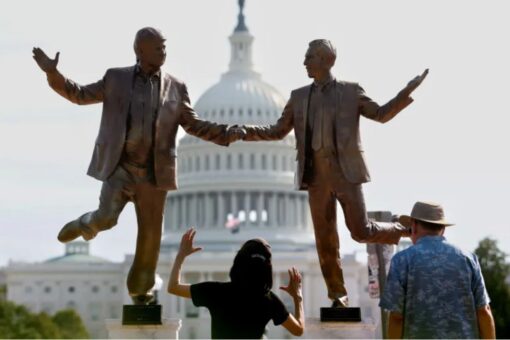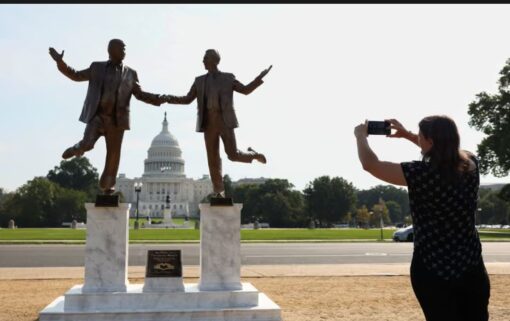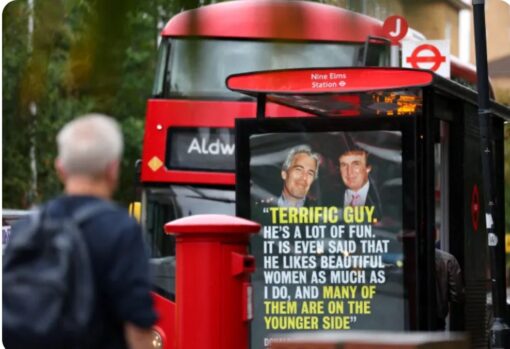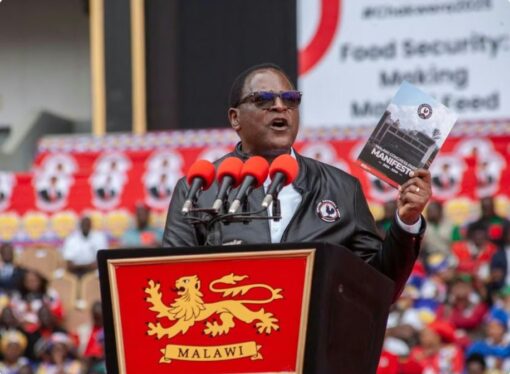A startling work of protest art has appeared without warning in Washington, D.C., showing U.S. President Donald Trump hand-in-hand with Jeffrey Epstein, the disgraced financier whose name continues to haunt American politics years after his death.
The installation, nicknamed by onlookers as the “Trump Epstein statue,” was erected on a grassy stretch near the Capitol on Tuesday and immediately drew crowds of photographers, critics, and curious passersby.
The life-sized bronze sculpture depicts the two men in a theatrical dance pose, frozen mid-step as if performing on stage. Trump’s figure is cast with his trademark suit and exaggerated hand gesture, while Epstein is sculpted with a grin that many found unsettling.
A small plaque beneath the statue simply read, “In honor of friendship month,” a phrase that has fueled speculation about the intentions behind the piece. While no artist or group has yet claimed responsibility, its appearance fits into a broader wave of politically charged street art that has targeted the president since his return to office.
Reactions were swift and divided. Supporters of the president denounced the installation as a smear, accusing anonymous critics of exploiting Epstein’s crimes to manufacture a scandal that never existed.

White House aides quickly moved to dismiss the episode as another partisan stunt. One spokesperson called the piece “juvenile mockery” and reminded reporters that Trump has previously stated he distanced himself from Epstein decades ago.
But detractors argue the “Trump Epstein statue” is not only satire but also a reminder of unanswered questions about the president’s past associations.
The location of the artwork was as provocative as its subject. By appearing within view of the Capitol dome, the statue instantly entered the national political stage.
Tourists took selfies while activists unfurled banners linking the sculpture to broader demands for transparency over Epstein’s networks of influence.
Online, the hashtag #TrumpEpsteinStatue trended throughout the day, pushing the story onto the global news agenda and reigniting debates about how art intersects with political accountability.
This is not the first time protest artists have used installations to lampoon Trump in the heart of the nation’s capital. Previous guerrilla pieces have included oversized inflatable caricatures, mock monuments, and a golden effigy that appeared briefly on the National Mall before being removed by security.
Each time, the goal has been to capture attention in a city saturated with political messaging. The Trump Epstein statue may prove the most incendiary yet, given the explosive history surrounding Epstein’s crimes and his connections to powerful figures worldwide.
For many onlookers, the imagery struck a nerve because it surfaced amid renewed scrutiny of documents linked to Epstein’s past. Earlier this month, a congressional panel published a trove of material allegedly connected to his personal circles, sparking rumors of correspondence and signatures resembling Trump’s.
While the president has denied writing any such messages and has launched lawsuits against media organizations reporting on the claims, the documents have kept the controversy alive.
Against this backdrop, the sudden unveiling of a sculpture mocking his relationship with Epstein appeared almost timed to maximize political damage.
Some art critics, however, see the statue less as an attack on Trump personally and more as a broader commentary on the intersection of power, wealth, and scandal in America.
“Public art has always been a barometer of public frustration,” said one Washington-based curator, noting parallels with Vietnam War protest sculptures and more recent movements like Occupy Wall Street.
“Whether you support the president or not, the Trump Epstein statue is designed to provoke conversation about complicity and accountability at the highest levels of power.”
The White House, for its part, attempted to project calm. In a brief statement, officials stressed that the president had no involvement with the installation and dismissed the controversy as “manufactured outrage from the same circles that have attacked him for years.”
Vice President JD Vance echoed that sentiment in a social media post, accusing Democrats of weaponizing “street art gimmicks” to undermine the administration. Pro-Trump commentators on conservative platforms argued that the outrage showed the desperation of the president’s opponents as the 2026 campaign cycle looms.
On the streets of Washington, the response was more complicated. Some residents applauded the creativity, saying satire has long played an essential role in democratic societies.
Others voiced discomfort at what they viewed as trivializing the crimes of Epstein by using his image in parody. “I’m no fan of Trump,” one onlooker said, “but this statue is disturbing because it makes Epstein almost cartoonish, and that risks forgetting the victims.” That tension — between humor, activism, and respect for those harmed — is likely to shape the ongoing debate about the installation.
Local authorities have not yet confirmed whether the statue will remain in place or be removed. Because the work appeared without permits, it technically violates city regulations governing public art displays on federal land. Park police were seen examining the site but had not dismantled the piece by nightfall.

In past cases, similar installations have been cleared within days, but sometimes only after drawing weeks of attention. If the Trump Epstein statue is removed quickly, its digital life on social media may prove more enduring than its physical presence on the Mall.
Meanwhile, the story has rippled far beyond Washington. International outlets picked up the images, broadcasting them alongside ongoing coverage of Trump’s United Nations address and other high-profile events.
For foreign observers, the episode has underscored the uniquely American phenomenon of blending protest art with political spectacle.
Some analysts suggested that the timing was deliberate, designed to shift global conversation from Trump’s speech on Gaza and Ukraine to the persistent shadows cast by Epstein.
What happens next remains uncertain. If the creators of the statue step forward, their explanation could reframe public understanding of the piece, either softening or intensifying its impact.
If they remain anonymous, speculation will continue to drive the narrative. In either case, the Trump Epstein statue has already succeeded in commanding national attention, injecting Epstein’s name back into headlines at a moment when the president would prefer to control the agenda.
For Trump, who has battled allegations, lawsuits, and protest art throughout his career, the sculpture is another reminder of how his presidency is never confined to official speeches or policy proposals.
Symbolism and satire chase him as relentlessly as cameras and reporters. The Trump Epstein statue may vanish from the Capitol grounds soon, but the imagery is unlikely to fade from memory, joining a growing archive of artistic interventions that mark this turbulent chapter in American politics.


